BMW logo
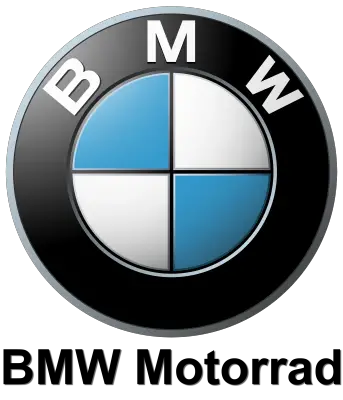
The company «Bayerische Motoren Werke AG» was founded in 1916 in Munich by the union of two small businesses — «Rapp-Flugmotoren Werke» and «Otto-Werke». These establishments produce aircraft engines from 1913.
| Information about the company BMW Motorrad | |
|---|
| Founded | 1916 |
| Founder | Franz Josef Popp Karl Rapp CamilloCastiglioni |
| Key people | Hendrik von Kuenheim (General Director) |
| Headquarters | Berlin, Germany |
| Slogan | ”Sheer Driving Pleasure” (Worldwide) “The Ultimate Driving Machine” (United States, United Kingdom) “The Ultimate Driving Experience” (Canada) “Freude am Fahren” (Germany) |
| Official website | www.bmw-motorrad.com |
After the association of aircraft manufacturing companies, established in 1913 by Karl Friedrich Rapp and Gustav Otto, they turned into a single concern, «BMV». In 1917 new firm got a logotype, which is used today without any changes.
BMW Motorcycle History
The company Bayerische Motoren Werke (BMW) rarely produced stylish motorcycles, in high demand. In its history, there were even moments when motor production was on the verge of a stop. But BMW has always acted on its plan and, as a result, produced a number of the most excellent ever produced multipurpose motorcycles.
| Formed by Bayerische Motoren Werke, which specializes in the production of aircraft engines. |
| A few weeks later, the Treaty of Versailles was signed, according to which Germany was forbidden to produce airplanes. BMW has no choice but to start producing motorcycles. |
| Developed two-stroke engine Kurier. |
|  Developed a model of the M2B15 motorcycle, where the first BMW motor for motorcycles, also known as the "Boxer," is used. |
| 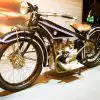 The legendary designer of BMW Max Fritz locks himself at home and creates drawings of a completely new motorcycle. Demonstrated the model R32 with a 486 cm³ engine in Paris. The new model can reach speeds of about a hundred kilometers per hour. |
| 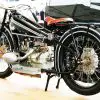 Issued racing version R32 under the index R37. On the model, R37 begin to put the front brakes, which subsequently begin to use and on the R32. |
| 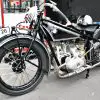 BMW is developing a model of the motorcycle R47, intended to replace R32, R37, and R39. |
| 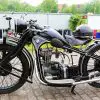 BMW begins to produce the largest motorcycle of its time R62, with a 750cm³ engine capable of developing a speed of 114 km/h. |
| 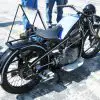 The economic crisis in Germany forces BMW to start producing a small R2 motorcycle with a 198cc engine. The peculiarity of the used engine was the unusual crankcase design of the engine. Small motorcycles with engines up to 200 cm³ in Germany do not require the right to drive, so R2 reached sales of 15,000 units. |
| 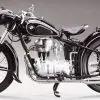 They release the model of the motorcycle R4. It installs a single-cylinder engine with an upper valve arrangement of 398 cm³. |
| The German army concludes a contract with BMW to produce R4 motorcycles for its needs, which allows the company to stay afloat during the Great Depression. |
| 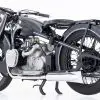 The production of the R12 motorcycle with the engine capacity of 745 cm³ begins. |
| 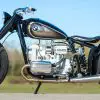 Model R5, becomes the first BMW motorcycle with running boards. Also begins production of the R7 model with an engine capacity of 500 cm³, capable of developing a speed of 140 km / h. |
| 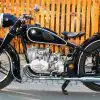 Starting with R61, BMW begins to put the footrests on the whole range of their motorcycles. This year begins production of six models of new motorcycles, including R23, R51, R66, and R71 |
|  BMW begins production of motorcycles R75, specially designed for military use. The US military was impressed by the capabilities of the R75 and the similar Zundapp model. German trophy bikes are sent to Harley-Davidson and Indian plants to start producing motorcycles with similar characteristics. Some 1,000 prototypes were produced, which were never actively used. |
| At the end of World War II, BMW stops producing motorcycles and concentrates on the development and production of bicycles. |
| 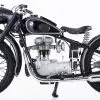 BMW starts producing again. Motorcycles and the first model on the conveyor become R24. Is used for a motorcycle, a 250cc engine, the maximum that is allowed under a peace treaty at that time. |
| 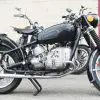 BMW starts producing new models of motorcycles R50/2 and R51/2. The quality of the motorcycle assembly was low. |
| 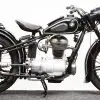 The production of the model R25 begins, with the rear hydraulic shock absorbers. |
| 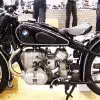 BMW starts producing a motorcycle R67 with an engine capacity of 600 cm³. |
| 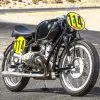 Starts production of a series of motorcycles RS. On motorcycles put a pendulum suspension. Appears motorcycle RS54 Rennsport. |
| The team consisting of Wilhelm Noll and Fritz Crone win the World Championship of motorcycles with a stroller. |
| 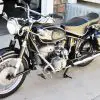 The production of the R50, which is intended to replace the R51/3, begins. |
| The number of motorcycles made falls from 23531 in 1955 to 5429 in 1959 due to the economic crisis. |
| 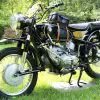 The production of the classic R69 begins. It becomes the fastest motorcycle, reaching a speed of 175 km/h. |
| Being developed special export versions of motorcycles R60 and R69 for the North American market. These models of motorcycles for the period from 1961 to 1968, were not launched into production. |
| Production of a new series of motorcycles equipped with an electric starter. |
| 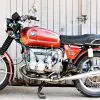 BMW celebrates its fiftieth anniversary and produces its 500,000 motorcycles off the assembly line. The release of the R90S model with an engine volume of 900 cm³ begins. They Begin production of 6 series of motorcycles. On motorcycles were installed engines in the volume of 600, 700 and 900 cm³. |
| For the first time, BMW is starting to put the five-speed gearbox on the produced motorcycles. |
| 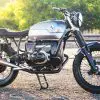 The production of 7 series of motorcycles begins, including the model R100/7 with an engine of 1000 cm³. Also begins production of the motorcycle R100RS, equipped with a similar 1000 cm³ engine and reaching a maximum speed of 200 km/h. |
| 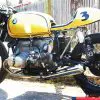 The production of the model R80/7 begins, which becomes the leader among motorcycles for the police. |
| 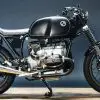 The production of a tourist motorcycle R100RT with an aerodynamic body kit begins. Also appeared model R45 with the engine volume of 473 cm³. |
| 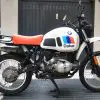 Begins production the enduro R80G/S with an engine of 800 cm³ |
| Hubert Oriole wins the third race in the history of Paris-Dakar, on a motorcycle BMW R80G/S specially prepared for heavy conditions. |
| 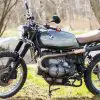 BMW begins to produce a road version of the R80G/S - R80RT. |
| 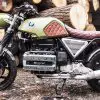 Begins the production of the K100 motorcycle - this is the first K-model with a liquid-cooled engine. |
| 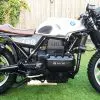 BMW creates its first model of the K75 motorcycle with a three-cylinder engine. |
| 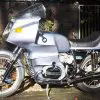 BMW radically upgrades the R100RS, using shock absorbers in the rear suspension |
|  Presented premium-class K100LT motorcycle with an engine capacity of 1000 cm³. |
| 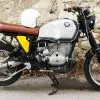 The beginning of production R100G/S, known as the largest enduro in the world, thanks to its weight of 210 kg. |
| 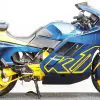 Production of the K1 model begins. |
| The production of the K100RS motorcycle with a four-valve engine begins. Installed on all models to a series K - system ABS. |
| A millionth motorcycle BMW was produced, which turned out to be a three-cylinder model K75RT. |
| 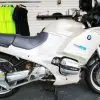 The production of a sports tourist motorcycle begins - R1100RS, which uses injector two-cylinder eight-valve engine. |
| The first motorcycle, for the last 30 years, is produced with a single-cylinder F650 Funduro engine. |
| This is the last year when traditional two-valve oppositional engines are produced. |
| 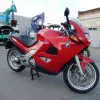 Begin to produce a powerful four-cylinder motorcycle K1200RS, with a liquid-cooled engine. |
| 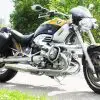 BMW starts producing its first R1200C chopper. Even though this model was James Bond's choice, this did not add to the popularity of the motorcycle. After several years, production discontinued. |
| Richard Saint wins the Paris-Dakar Rally on the "Funduro," equipped with a single-cylinder engine of 650cc. Officially, this model is called F650RR. |
| The production of R1150GS, premium tourist motorcycle K1200LT begins. |
| At R1200GS begin to put, a new more lightweight and powerful engine. The K1200S, this is an entirely new motorcycle for a conservative manufacturer like BMW. The K1200S used a four-cylinder standard engine, which produces 165 horsepower. |
| There is a rumor about the preparation of the S1000RR motorcycle, with a four-cylinder, liter engine, which plans to participate in the World Superbike Championship in 2009. |
BMW Logo History
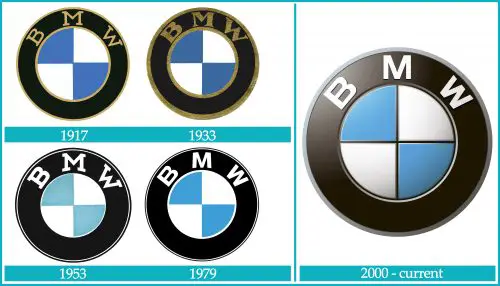
Until recently, the history of the origin of the BMW logo had no confirmed facts and evidence of any true causes of occurrence of the emblem. Nowadays many people believe and believed that the BMW logo originates from the parent company founded by Karl Rapp. But in fact, it is not true!
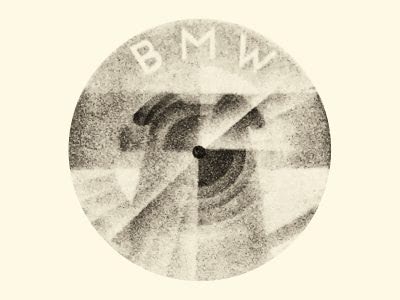
The aircraft designer, engineer Karl Rapp worked for Flugwerk Deutschland and actually was the head of the company. The company was engaged in the production and sale of aircraft. However, the shareholders of the company decided to liquidate it and decline Karl’s services. On October 28, 1913, Karl Rapp and his partner Julius Auspitzer purchased the production facilities of Flugwerk Deutschland and founded their own company, Karl Rapp Motorenwerke GmbH.
The history of BMW begins with two small aircraft engine firms, created respectively by Karl Rapp and Gustav Otto (the son of Nikolaus August Otto, the inventor of the internal combustion engine) in 1913 in Munich. In 1914 the First World War began, and the German state began to experience a great need for aircraft engines. This moved the two designers to unite in one big factory. In July 1917, this plant was officially registered under the name of Bayerische Motoren Werke, and the BMW brand came into being.
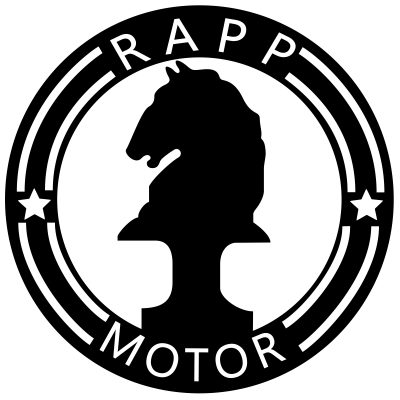
When Karl Rapp Motorenwerke GmbH Company developed into the BMW AG Company, they wanted a new BMW logo to be focused on their logo. The Rapp logo was made in the form of a circle where the inscription Rapp was printed on top, and Motor was printed below, there was a figure of a horse in the middle of the logo.
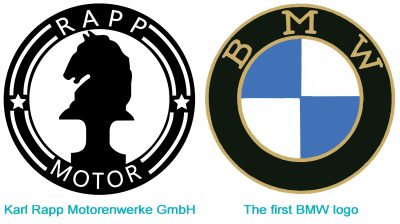
The new BMW Company used the form of the logo, placed the letters just like Karl Rapp Motorenwerke, but filled the middle of the logo with white and blue colors.
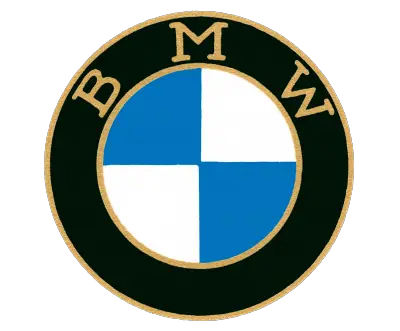
It is commonly believed that there have been 5 stages of change in the history of the logo, namely: 1917 (the very first logo), 1933, 1953, 1979, and the current version of the modern 3D logo since 2000.
| 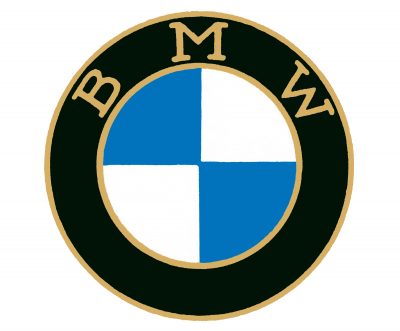 The BMW logo of 1917 The BMW logo of 1917There were white and blue colors inside the logo, gold edging on a circle and between the inner circles. The lettering was also made in golden color. |
| 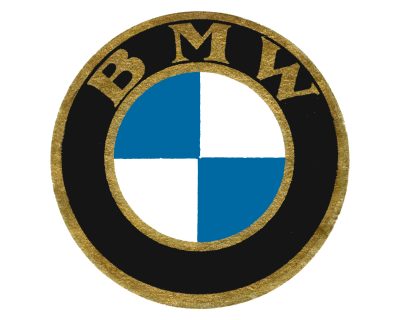 The BMW logo of 1933 The BMW logo of 1933The colors inside logo remained the same. The edging along the contour lines of the logo and inside were increased. The BMW lettering was changed into for bolder and clearer one. |
| 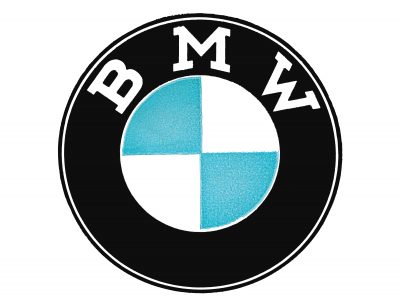 The BMW logo of 1953 The BMW logo of 1953The company moved away from the golden color in the logo, and at that time the white color of the logo moldings was used instead. The return of the company inscription on the logo to the font of 1917, only to a slightly bolder one and made in white color. The pale blue color was used instead of a deep blue color in the middle of the logo. |
| 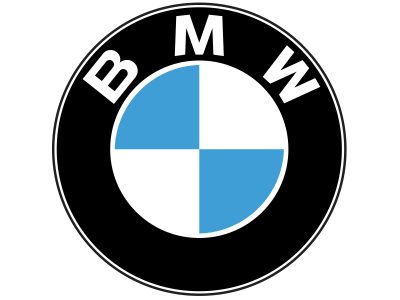 The BMW logo of 1979 The BMW logo of 1979The font color remains white, but the font itself was changed to a more modern, sans serif. The deep blue color was returned to the middle of the logo. |
| 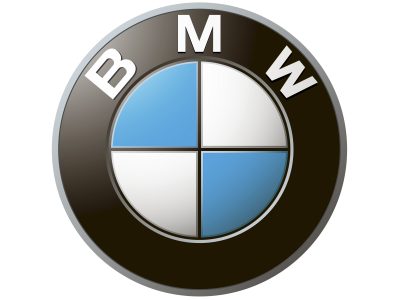 The BMW logo of 2000 The BMW logo of 2000A modern version of a logo made in 3D style. |
The basic elements of the logo have not been changed for all the time of the existence of the company, these are:
- Cirсle
- BMW inscription along the contour of the circle
- 2 colors in the middle of the logo which are oppositely located.
Why is the BMW Logo Blue and White
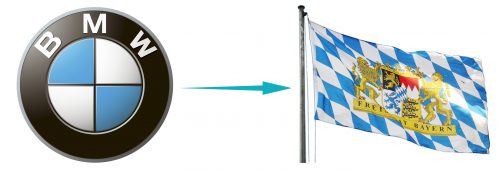
Another myth of this logo is the colors that filled the middle of the company’s logo. Many people believe that white and blue colors are associated with the sky, and taking into account the history of the company, associated with aircraft manufacturing, that is why these 2 colors are presented there. In fact, these colors were present on the flag of the free state of Bavaria (which is still a part of Germany today), where the production of the company was located. Blue and White colors were in the opposite order because, at that time, it was forbidden to use national symbols in trademarks.
BMW logo meaning
[caption id=“attachment_6220” align=“aligncenter” width=“400”]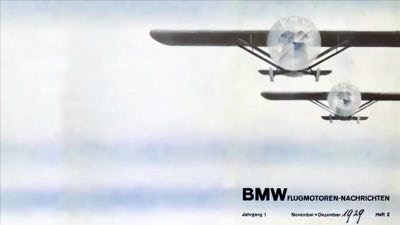 BMW logo propeller in the journal in 1929[/caption]
BMW logo propeller in the journal in 1929[/caption]
The myth that the modern BMW logo is a legacy of aviation companies appeared after advertising in a magazine published in 1929, which depicted a plane with a rotating propeller, which showed the letters BMW. This advertising appeared at a time when BMW acquired a license for the creation of Pratt &Whitney aircraft engines, and the advertising department wanted to use Roundel and the name of BMW in an attempt to increase sales of its engines.
[caption id=“attachment_6221” align=“aligncenter” width=“400”]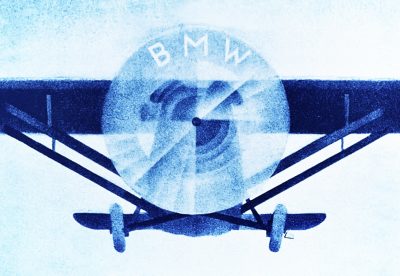 BMW logo propeller in the journal in 1942[/caption]
BMW logo propeller in the journal in 1942[/caption]
Later, this myth became perpetuated, namely after an article appeared in the BMW magazine in 1942, where a plane with the rotating propeller was also shown.
New BMW Logo
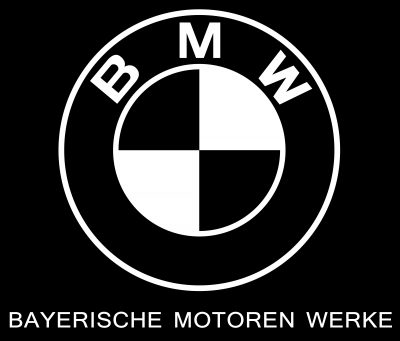
We are all used to the blue and white BMW logo, which is often called a “propeller”, although it represents the flag of Bavaria. But soon we will have to get used to its new variations. The most expensive and luxurious models from this carmaker will get a new black-and-white logo, which will be accompanied by the inscription “Bayerische Motoren Werke”.
We are talking about several flagship models in different segments. This is the eighth series coupe, a large crossover BMW X7, and BMW i8 hybrid coupe.
By the way, it is the first time in the history of BMW, when the German automaker will use two systems of the logo on their cars.
Emblem BMW
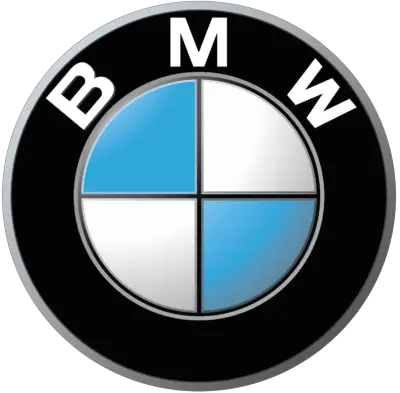
The emblem looks like a propeller of «Bavarian Luftwaffe» military aircraft. Speaking about the selection of colors for the logo, there are two versions. The first variant is propeller blades against the blue sky. The second is connected with the old tradition of painting military aircraft in the colors of the flag of the region (the main colors of the Bavarian flag are white and blue).
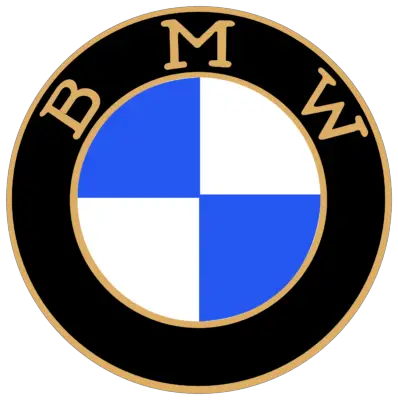 «The sky will reflect on your car hood» is an official advertising slogan of «BMW». But not everyone knows that automobiles of this firm really come «out of the sky». In the 19-20th centuries, any technique, including the car was a very expensive pleasure. A lot of automobile companies started their careers from producing bicycles and their details, motorcycles, aircraft engines, and even the first planes. The company «BMW», even though it was carefully hidden, belongs to the last.
«The sky will reflect on your car hood» is an official advertising slogan of «BMW». But not everyone knows that automobiles of this firm really come «out of the sky». In the 19-20th centuries, any technique, including the car was a very expensive pleasure. A lot of automobile companies started their careers from producing bicycles and their details, motorcycles, aircraft engines, and even the first planes. The company «BMW», even though it was carefully hidden, belongs to the last.
Pay attention to the modern logotype of the company. The circle, divided into 4 segments, is a «rotating propeller». This is a masked reference about the firm`s very first occupation (producing of aircraft engines). The main colors are white and blue (the primary colors of the Bavarian flag).
 BMW logo propeller in the journal in 1929[/caption]
BMW logo propeller in the journal in 1929[/caption] BMW logo propeller in the journal in 1942[/caption]
BMW logo propeller in the journal in 1942[/caption] «The sky will reflect on your car hood» is an official advertising slogan of «BMW». But not everyone knows that automobiles of this firm really come «out of the sky». In the 19-20th centuries, any technique, including the car was a very expensive pleasure. A lot of automobile companies started their careers from producing bicycles and their details, motorcycles, aircraft engines, and even the first planes. The company «BMW», even though it was carefully hidden, belongs to the last.
«The sky will reflect on your car hood» is an official advertising slogan of «BMW». But not everyone knows that automobiles of this firm really come «out of the sky». In the 19-20th centuries, any technique, including the car was a very expensive pleasure. A lot of automobile companies started their careers from producing bicycles and their details, motorcycles, aircraft engines, and even the first planes. The company «BMW», even though it was carefully hidden, belongs to the last.















































